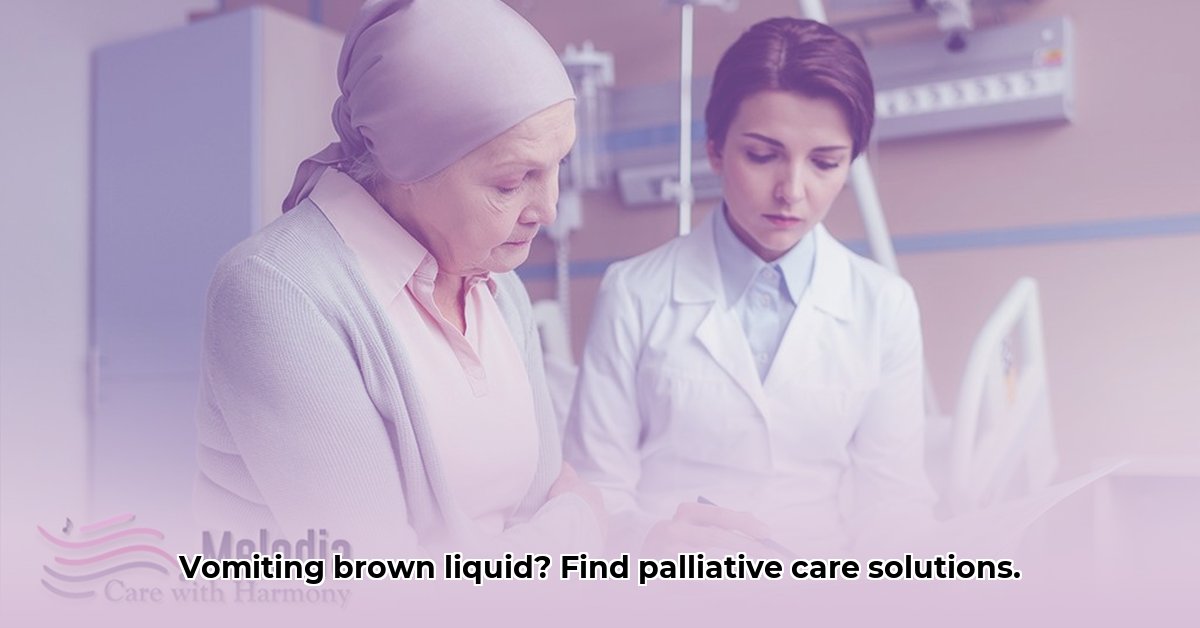“`markdown
End-of-Life Vomiting Brown Liquid: Understanding Causes and Palliative Care Solutions
Witnessing a loved one vomit, particularly brown vomit, near the end of their life is a distressing experience. Beyond the physical discomfort, it evokes emotional distress for everyone involved. This article aims to provide clarity on why vomiting brown liquid necessitates immediate attention, explore potential causes, and offer practical strategies to provide comfort and support. We will cover comfort measures, medical treatments, and the importance of comprehensive palliative care. Our goal is to empower you with the knowledge necessary to navigate this difficult period with empathy and assurance, ensuring the final moments are as peaceful as possible.
Understanding Vomiting Brown Liquid at the End of Life: Causes and Concerns
The sight of brown liquid vomit in a loved one nearing the end of their life is undoubtedly alarming. This symptom often signifies a serious underlying issue, demanding prompt attention. Unlike typical vomit associated with indigestion, brown vomit often indicates the presence of blood in the digestive system. Let’s examine potential causes and therapeutic interventions, emphasizing palliative solutions.
Deciphering the Causes: Internal Bleeding and Other Factors
Brown liquid vomit, as opposed to the greenish or yellowish hues of typical vomit, often suggests the presence of blood altered by the digestive process. Several factors may contribute to this concerning symptom as someone approaches the end of their life:
- Underlying Medical Conditions: Advanced cancers, heart failure, or liver disease can weaken blood vessels in the digestive tract, increasing the likelihood of bleeding. As the body weakens, its capacity for self-repair diminishes, potentially leading to internal bleeding.
- Medications: Paradoxically, some medications intended to manage pain or other symptoms can increase the risk of gastrointestinal bleeding or upset, potentially resulting in brown liquid vomit. Maintaining open communication with the medical team regarding all medications is critical.
- Bowel Obstructions: Intestinal blockages can occur as a serious complication in end-of-life care, hindering digestion and potentially leading to the vomiting of dark, digested blood. The pressure and compromised tissue associated with a bowel obstruction can also lead to bleeding.
- Esophageal Varices: These are enlarged veins in the esophagus, often caused by liver disease. They are fragile and prone to bleeding, which can be vomited.
- Gastric Ulcers or Gastritis: Ulcers in the stomach lining, or inflammation of the stomach lining, can bleed.
It’s important to recognize that this list is not exhaustive. A range of factors could contribute to this symptom. The key takeaway is that brown liquid vomit is a serious warning sign that requires immediate medical evaluation. What proactive steps can you take to communicate effectively with the healthcare team about these observations?
Assessment and Diagnosis: A Systematic Approach – Diagnostic Procedures
Upon the presentation of brown liquid vomit, healthcare professionals will undertake a systematic evaluation to determine the underlying cause and recommend an appropriate management plan. This typically involves:
- Detailed Medical History Review: The healthcare team will inquire about the patient’s medical history, including any existing conditions, current medications, and the timeline of symptoms.
- Comprehensive Physical Examination: A physician will conduct a physical examination to assess for signs of dehydration (dry mouth, reduced urination), low blood pressure, and other symptoms related to bleeding, such as abdominal tenderness or distention.
- Diagnostic Testing: Blood tests will be performed to evaluate blood counts (looking for anemia), clotting factors, and markers of organ function. Imaging studies, such as ultrasounds, X-rays, or CT scans, may be necessary to visualize the digestive system and identify potential sources of bleeding or obstruction. Stool tests can check for the presence of blood.
- Endoscopy: In some cases, an upper endoscopy may be performed. This involves inserting a thin, flexible tube with a camera into the esophagus and stomach to visualize the lining and identify any bleeding or abnormalities.
These steps are crucial for accurate diagnosis and the formulation of an effective treatment strategy. Early identification of the underlying cause is essential for managing symptoms and maximizing comfort during end-of-life care. How does early diagnosis affect patient outcomes and overall well-being?
Comfort and Relief: Non-Pharmacological Interventions – Natural Remedies
Before resorting to medications, several non-pharmacological strategies can be implemented to help alleviate nausea and vomiting:
- Small, Frequent Meals: Offer small portions of easily digestible, bland foods at frequent intervals throughout the day.
- Managing Odors: Minimize exposure to strong odors that can trigger nausea. Ensure the room is well-ventilated and avoid strong perfumes or cooking smells.
- Cool Compresses: Applying a cool, damp cloth to the forehead or back of the neck can provide soothing relief.
- Relaxation Techniques: Encourage relaxation techniques, such as deep breathing exercises, meditation, or listening to calming music, to reduce stress and anxiety, which can exacerbate nausea.
- Oral Hygiene: Regular oral hygiene can help to remove unpleasant tastes and reduce nausea.
- Ginger: Ginger has natural anti-nausea properties. Ginger ale, ginger tea, or ginger candies may provide relief.
- Acupressure: Acupressure bands worn on the wrists may help to alleviate nausea.
- Elevate the Head: Elevating the head of the bed can help to prevent stomach acid from flowing back up into the esophagus, which can reduce nausea.
These methods focus on alleviating discomfort without the use of medication. They are often used in conjunction with medical treatments. Could implementing these strategies enhance the effectiveness of pharmacological interventions in managing end-of-life symptoms?
Medical Interventions: Medications to Control Nausea and Vomiting – Antiemetic Drugs
A physician may prescribe antiemetic medications to manage nausea and vomiting. The selection of medication depends on the underlying cause, the patient’s overall health, and other considerations. Commonly used examples include:
- Antihistamines (e.g., Promethazine, Diphenhydramine): These medications can block histamine receptors in the brain, reducing nausea and vomiting.
- Serotonin Receptor Antagonists (e.g., Ondansetron): These are highly effective for nausea caused by chemotherapy or other medical treatments.
- Dopamine Antagonists (e.g., Metoclopramide, Prochlorperazine): These drugs block dopamine receptors in the brain, which can help to reduce nausea and vomiting. Metoclopramide also helps the stomach empty faster.
- Corticosteroids (e.g., Dexamethasone): These can reduce inflammation and are often used in combination with other antiemetics, particularly in cases of bowel obstruction or increased intracranial pressure.
- Benzodiazepines (e.g., Lorazepam): These can help reduce anxiety, which can worsen nausea and vomiting.
Important Disclaimer: The information provided herein is intended solely for educational purposes and should not be construed as medical advice. Always consult with a qualified healthcare professional to determine the most appropriate medication and dosage for your specific situation. Self-medicating can be dangerous. The effectiveness of antiemetics can vary, so a healthcare professional will assess your needs.
Holistic Palliative and Hospice Care: Enhancing Well-being
Palliative care prioritizes comfort and quality of life by addressing physical and emotional needs. It is not about ceasing treatment, but rather about managing symptoms and improving overall well-being. Hospice care offers comprehensive support for individuals with life-limiting illnesses. Both palliative and hospice care provide crucial support for patients and their families. Palliative care improves the overall quality of life.
Effective Communication: The Corner Stone of Quality Care – Comprehensive Support
Maintaining open communication among the patient, family, and healthcare team is paramount. Do not hesitate to ask questions, express concerns, and share observations. Clear and regular communication is essential for ensuring effective management and providing comprehensive emotional support. How can families be better prepared to initiate these essential conversations with healthcare providers?
Recognizing When Immediate Medical Intervention is Needed: Emergency Situations
Seek immediate medical assistance if:
- Vomiting is severe, persistent, and uncontrollable.
- The patient exhibits signs of dehydration (e.g., decreased urination, dry mouth, dizziness).
- The amount or color of the brown liquid vomit increases significantly.
- The patient experiences severe abdominal pain.
- The patient shows signs of weakness, dizziness, confusion, or altered mental status.
- Other symptoms worsen considerably.
Prompt medical intervention can be crucial in managing the underlying cause of brown liquid vomit and minimizing complications. What are the key indicators that necessitate immediate intervention, and how can caregivers be educated to recognize them effectively?
Conclusion: Providing Comfort and Support Throughout the Final Stages
Managing end-of-life vomiting of brown liquid effectively requires a comprehensive approach. Early identification and treatment of the underlying cause, in conjunction with comfort measures and compassionate support, can significantly improve the patient’s quality of life during this challenging period. Remember, you are not alone. A collaborative, team-based approach will help ensure the most compassionate care possible. Ongoing research continues to enhance our understanding of treatment strategies in this critical area.
Enhancing Antiemetic Efficacy for End-of-Life Nausea: Advanced Treatment Strategies
Key Considerations:
- Nausea and vomiting are common, yet can be intensely distressing, in advanced illness.
- Numerous factors contribute to nausea and vomiting, making a simplistic, mechanistic approach to treatment inadequate.
- While various antiemetics can be effective, the quality of evidence supporting their use is oftenLimited.
- Older individuals face unique challenges related to their physiology and how their bodies process medications.
- There is a crucial need for improved assessment tools and more rigorous research,
- Achieve Anesthesiology Work-Life Balance: Your Guide - December 4, 2025
- Unlock Young Doctors’ Work-Life Balance: Actionable Strategies Now - December 2, 2025
- Unlock Life Harmony: Work-Life Integration Guide - November 30, 2025













